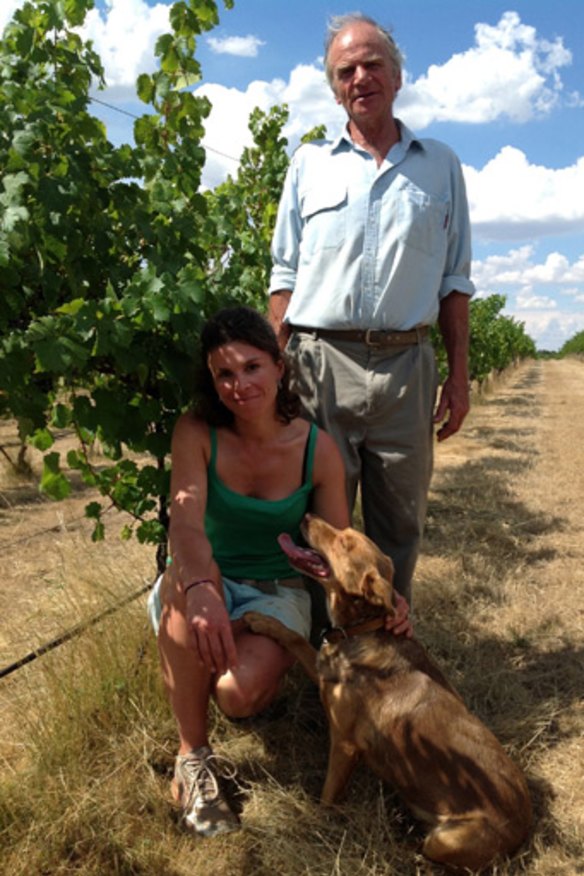On the rocky road to glory
A family team produces some of the country's finest drops from some of its harshest terrain.

CONDAH, IN VICTORIA'S WEST, IS 331 kilometres or four hours by car from Melbourne's city centre. The trip skirts three acknowledged wine regions - Geelong, Ballarat and the Grampians - before arriving at the less-acknowledged Henty.
The regional name is little known, but it is home to a winemaker that will be familiar to almost every Australian riesling and cabernet drinker - Crawford River.
This is hard-scrabble sheep and cattle country, making the presence of a vineyard - and one of the country's premier riesling sites at that - all the more remarkable. That is, until you meet the man behind it.
John Thomson gives every impression that should the fancy take him, he could grow vines on the Nullarbor.
Tall and tanned from long hours outdoors, Thomson has a killer handshake and a country squint courtesy of a lifetime under the blistering Australian sun. He describes himself as a ''gardener''. He's as blunt as a worn axe and given to freely expressing opinions that sometimes get him into trouble with his winemaker daughter, Belinda, whom he calls Bee.
''In your opinion, dad,'' she'll say, in explanation of her father's occasional politically incorrect forthrightness. You have to suspect he enjoys their little game.
Thomson talks of his peasant genes, and he knows his land. Since 1872 and over four generations, the Thomsons have farmed Crawford River for cattle and sheep. In 1975, Thomson and his wife, Catherine, branched out into vines.
''I didn't set out to grow grapes,'' he says. ''I set out to make wine.'' There was more money in the latter, he adds by way of explanation.
Riesling and cabernet sauvignon were the most popular grapes of the day, so that's what Johnson planted.
An early inspiration was Karl Seppelt, who in 1964 planted the Drumborg vineyard on virgin grape-growing land nearby at Portland. It was the coldest vine-growing site in the state with high rainfall, but Seppelt made it work.
Thomson, whose vineyard shared a similar climate, saw that as a sign.
''I didn't know much about getting grapes going,'' he says, ''but we had a 97 per cent success [strike] rate, so god meant there to be a vineyard here.''
He also planted semillon and sauvignon blanc - ''I wanted to make Chateau d'Yquem.''
Nearby, the dormant volcano of Mount Eccles (Budj Bim) played a role, creating layers of gravelly volcanic soils over limestone, the result of an uplifted ancient seabed. The convergence of the two different soil types provided a kind of X-factor for future Crawford River wines, riesling in particular.
Some call that X-factor minerality. ''I think the debate about minerality is a bit of a wank,'' Thomson says. ''Ask five people and you'll get four answers.''
Belinda considers the minerality in their wines ''stony'', contributing texture. ''But I can't prove it.''
Acid and minerals - whether from the limestone, ironstone or bluestone - have a tightly coiled presence in the Crawford River wines. Every year spent in bottle, the coil loosens a little. The 2003 semillon - a 10-year-old current release - is still youthful and herbal, the only sign of age being a slight softening of the acidity.
This is no aberration. The 2005 riesling and reserve riesling are about to be re-released, and even though they are drinking so well right now, they are not yet fully formed. The '05 reserve riesling, in particular, looks almost preposterously juvenile.
The 2006 cabernet sauvignon, about to be released, is earthy and savoury, and just coming together. There will be no 2007 cabernet due to frost.
''We have proven over the years that nearly all of our wines age well,'' Thomson says. The exception would be the cabernet-based rose´, and possibly the semillon sauvignon blend, although Belinda is working on the latter, a special project wine inspired by her regular winemaking gigs in Spain.
There's no name yet, but new and old oak and time on the lees (sediment made of dead yeast, grape skins and pips) are involved.
Having the freedom to do what they want, like regularly keeping back wine for 10 years, contributes to Crawford River's popularity with drinkers and sommeliers.
''I'm not driven by a sales budget,'' Thomson says. ''We release a wine when it's singing.''
They separate the age of their vines when making wine; the young vines for riesling, about 10 years of age, is a case in point. I suspect it is one of the few wines of its kind labelled that way in Australia.
The complex flavour revealed in a wine made from older vines is quite rightly prized, but the exuberant, bouncy fruit flavours that emerge in the Crawford River 2011 Young Vines riesling are also celebrated.
The 2012 riesling from the Thomsons is another story: a rolling, herbal, dusty, spice-charged and citrus-infused beauty of a wine suggestive of many things, all fruit-induced, but mostly of intensity.
Keeping their palates fresh and responsive in one of the country's most isolated wine regions is something the Thomsons take seriously. ''We don't drink our wines here, at least not that much. We're scared of getting a cellar palate,'' he says.
Empty wine bottles from France, Austria, Germany, Spain and Portugal sitting on top of the kitchen cupboard speak of an international palate. Trips to those places, often at vintage times for Belinda, reinforce the impression.
''We're always looking at ways to improve,'' says Belinda, who spends up to six months a year in Spain.
''It keeps you on your toes,'' her father says.